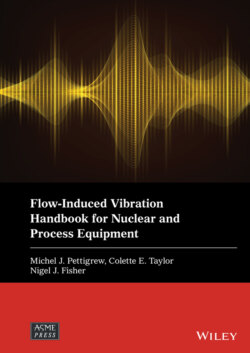Читать книгу Flow-Induced Vibration Handbook for Nuclear and Process Equipment - Группа авторов - Страница 40
Single‐Phase Cross Flow
ОглавлениеIn single‐phase cross flow, two distinct flow fields are possible. Interior tubes, well within a heat exchanger tube bundle, are excited by turbulence generated within the bundle. This excitation is governed by the tube bundle geometry. On the other hand, upstream or inlet tubes are excited by turbulence generated by upstream components such as inlet nozzles, entrance ports and upstream piping elements. Upstream turbulence levels are governed by the upstream flow path geometry and are very often much larger than those generated within the bundle. Such excitation is often referred to as far‐field excitation.
Random turbulence excitation is usually not a problem with gas or vapor cross flow. The pressure fluctuations and resulting excitation forces due to gas cross flow at a given velocity are generally an order of magnitude less than those for a liquid or two‐phase mixture at the same velocity. However, gas velocities can be extremely high and at high pressure the densities can be significant. Therefore, some consideration should be given to random excitation in high‐pressure gas heat exchangers.
Taylor and Pettigrew (2000) combined data from many sources to arrive at the reference EPSD guideline shown in Fig. 2-14. The lower bound, shown in Fig. 2-14, should be used when the upstream turbulence is less than or equal to the turbulence within the tube bundle. The upper bound, shown in Fig. 2-14, should be used if the upstream turbulence exceeds the turbulence inside the tube bundle. The boundaries are defined as follows:
Fig. 2-14 Proposed Guideline for Single‐Phase Random Excitation Forces (References Provided in the Legend can be found in Taylor and Pettigrew (2000)).
(2.31)
(2‐32)
For single‐phase flow fo = Up/D and .
In most cases, the random excitation forces for interior tubes are significantly lower than for upstream tubes. The vibration response of the upstream tubes will be larger. Thus, it may not be necessary to consider the vibration response of interior tubes when they are otherwise identical to the upstream tubes.
